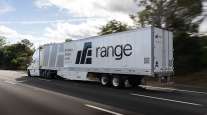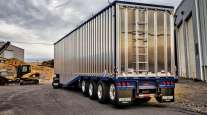Senior Reporter
Trailer Orders Continue to Mount, and So Does Pressure on Trailer Makers
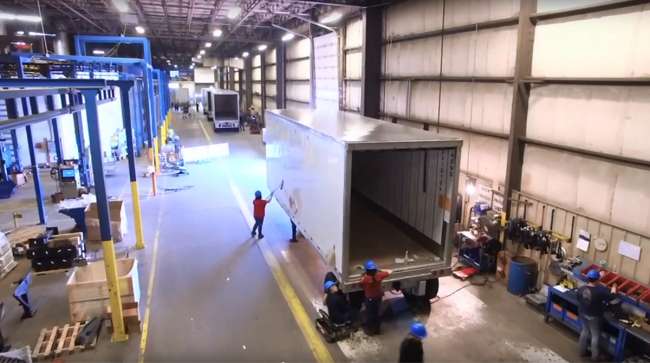
U.S. trailer orders continued to mount in April, tightening the pressure on trailer makers to secure the components and labor needed to boost production amid the rising cost of materials.
ACT Research Co. reported April’s trailer orders climbed 11% year-over-year to 23,100, citing preliminary data it would revise when the final figures are available.
“April is the 17th straight month of year-over-year gains for orders,” Frank Maly, ACT’s director of commercial vehicle transportation analysis and research, told Transport Topics.
“The challenge for fleets is finding equipment and getting it on a timely basis. [In April] there was a seven- to eight-month backlog. That pretty much wipes out this year,” he said.
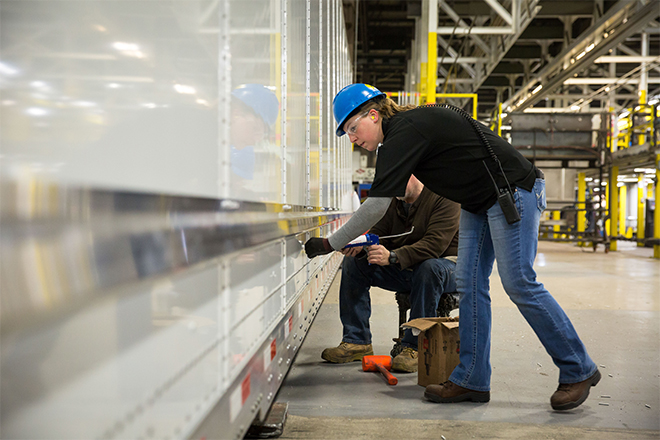
Employees work on a trailer at the Stoughton, Wis., plant. (Stoughton Trailers)
Any dealers who have stock probably won’t have it for long, he added.
Maly said orders for refrigerated trailers could be up 30% year-over-year once the final figures for April are in. “There is pressure [for equipment] throughout the cold chain.”
FTR pegged the orders at 22,000, noting orders have totaled 330,000 for the past 12 months.
Trailer makers acknowledged they faced many high hurdles in meeting demand.
“The rising and unmanageable cost of raw materials and the tight supply of many components are adding challenges that require a great deal of attention,” said Glenn Harney, chief sales officer at Hyundai Translead, which increased market share significantly in 2017 and so far in 2018.
Hyundai Translead still has some production space in the fourth quarter, he said, but is already seeing higher than normal requests for reserved production in 2019. “This is primarily related to dry freight vans.”
At East Manufacturing, almost every line is working six days a week, 24 hours a day, said President Dave de Poincy. “Labor is tight. I need 100 new welders today.”
Adding to that pinch, materials are going up higher and faster than he can adjust pricing on trailers.
“We are planning an announcement of a third increase since December 2017,” he said. “Lead times and component availability are getting stretched to the limits. No allocations yet, but they may be coming.”
East’s backlog is at an all-time high and is full through the end of September and 50% filled through December and on into 2019, de Poincy said in May.
The surge in commodity prices, especially steel and aluminum, “is partly due to the potential tariffs and partly due to high demand,” said Dave Gilliland, vice president of national accounts at Great Dane.
“There is a strong freight environment and our customers need the equipment to take care of demand,” he said.
Meanwhile, allocations have already been imposed by some suppliers, said Charles Willmott, chief sales officer at Strick Group.
“It means that some suppliers are telling trailer makers the maximum amount of raw material or components they can have per month,” he said. “For instance: ‘Until further notice we have placed a maximum of 1,000 pounds of rivets that we will sell you per month.’ There is some, but not much of this going on today.”
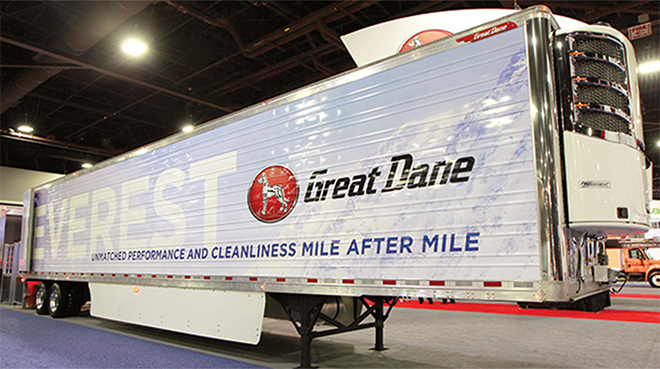
(John Sommers II for Transport Topics)
More often, a capacity-constrained supplier will quote longer lead times to the trailer makers, he added. “Both have a similar limiting effect on the trailer maker’s output.”
Willmott noted the difficulty in forecasting prices in the third and fourth quarters, plus 2019, but said trailer prices would rise as much as 10% by this time next year. “Demand for materials and components from trailer makers was high but relatively in balance with supply until the steel and aluminum tariffs were announced by the current administration two months ago. Since then OEM costs have risen sharply and continue to rise unabated.”
David Giesen, vice president of sales at Stoughton Trailers, said, “Customers are starting to comment on the ‘sticker shock’ for new trailers, but continue to buy.” He sees no letup in demand.
“It looks like this year is going to continue strong; no end in sight at this point,” Giesen said.
The availability of materials could keep 2018 from being a new record year for the industry, Wabash National Corp. President Brent Yeagy said during an earnings conference call in April.
At the same time, the tank trailer business is experiencing its highest backlog in three years, he said.
“Increasing general manufacturing output, new domestic chemical manufacturing coming online and to a lesser degree, growth in oil and gas are contributing to the need for additional tanker units,” Yeagy said.
One new player has come along to vie for trailers — digital freight broker Convoy.
In May Convoy launched a program for small carriers and owner-operators that enables them to use their power equipment to pick up Convoy’s pre-positioned, loaded trailers from shippers in select areas.
“Convoy is leasing the trailers. We’re not sharing any details beyond that at this time,” company spokeswoman Sarah Tobis said.


